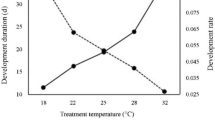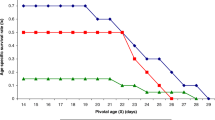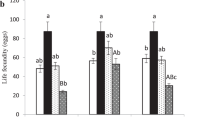Abstract
Meteorus pulchricornis is a parasitic wasp, which plays an important role in the biological control of lepidopteran pests. Through assessment of the effect of host instar and temperature on fitness-related traits of M. pulchricornis, this study ascertained the establishment potential of M. pulchricornis in the fields. Results showed that M. pulchricornis accepted Spodoptera exigua for oviposition and the progenies developed successfully in hosts of all ages at three constant temperatures, 20°C, 25°C and 30°C. Parasitoid survivorship from oviposition to adult eclosion was highest at 25°C, followed by 20°C and 30°C. Cocoon weight and hind tibia length differed significantly when the parasitoid was exposed to 20°C, 25°C and 30°C. The fitness-related traits of M. pulchricornis did not increase linearly with the host age at different temperatures. The host quality was found to be optimal at intermediate host instars, which the female parasitoid preferred to parasitize. The larval development rate increased with temperature in a linear fashion up to 30°C. The threshold for larval and pupal development of M. pulchricornis was 4.2°C and 1.6°C, respectively. These results have implications for predicting the population dynamics of M. pulchricornis in situ and optimizing mass rearing of the parasitic wasp under laboratory conditions.

Similar content being viewed by others
References
Beckage, N. E., & Gelman, D. B. (2004). Wasp parasitoid disruption of host development: implications for new biologically based strategies for insect control. Annual Review of Entomology, 49, 299–330.
Bell, H. A., Marris, G. C., Smethurst, F., & Edwards, J. P. (2003). The effect of host stage and temperature on selected developmental parameters of the solitary endoparasitoid Meteorus gyrator (Thun.) (Hym., Braconidae). Journal of Applied Entomology, 127, 332–339.
Berry, J. A. (1997). Meteorus pulchricornis (Wesmael) (Hymenoptera: Braconidae: Euphorinae): a new record for New Zealand. New Zealand Entomologist, 20, 45–48.
Berry, J. A., & Walker, G. P. (2004). Meteorus pulchricornis (Wesmael) (Hymenoptera: Braconidae: Euphorinae): an exotic polyphagous parasitoid in New Zealand. New Zealand Journal of Zoology, 31, 33–44.
Colinet, H., Salin, C., Boivin, G., & Hance, T. H. (2005). Host age and fitness-related traits in a koinobiont aphid parasitoid. Ecological Entomology, 30, 473–479.
Ellers, J., Bax, M., & van Alphen, J. J. M. (2001). Seasonal changes in female size and its relation to reproduction in the parasitoid Asobara tabida. Oikos, 92, 309–314.
Fuester, R. W., Taylor, P. B., Peng, H., & Swan, K. (1993). Laboratory biology of a uniparental strain of Meteorus pulchricornis (Hymenoptera: Braconidae), an exotic larval parasite of the gypsy moth (Lepidoptera: Lymantriidae). Annals of the Entomological Society of America, 86, 298–304.
Fusco, R. A. (1981). Meteorus pulchricornis (Wesmael). In C. C. Doane, & M. L. McManus. (Eds.), The gypsy moth: research toward integrated pest management. USDA Technical Bulletin.
Godfray, H. C. J. (1994). Parasitoids: behavioral and evolutionary ecology. Princeton, NJ, USA: Princeton University Press.
Greenfield, M. D., & Karandinos, M. G. (1976). Fecundity and longevity of Synanthedon pictipes under constant and fluctuating temperatures. Environmental Entomology, 5, 883–887.
Hardy, I. C. W. (2002). Sex ratios: concepts and research methods. Cambridge, UK: Cambridge University Press.
Harvey, J. A. (2005). Factors affecting the evolution of development strategies in parasitoid wasps: the importance of functional constraints and incorporating complexity. Entomologia Experimentalis et Applicata, 117, 1–13.
Harvey, J. A., & Strand, M. R. (2002). The developmental strategies of endoparasitoid wasps vary with host feeding ecology. Ecology, 83, 2439–2451.
Harvey, J. A., Bezemer, T. M., Elzinga, J. A., & Strand, M. R. (2004). Development of the solitary endoparasitoid Microplitis demolitor: host quality does not increase with host age and size. Ecological Entomology, 29, 35–43.
Hentz, M. G., Ellsworth, P. C., Naranjo, S. E., & Watson, T. F. (1998). Development, longevity and fecundity of Chelonus sp. nr curvimaculatus (Hymenoptera: Braconidae), an egg-larval parasitoid of pink bollworm (Lepidoptera: Gelechiidae). Environmental Entomology, 27, 443–449.
Jackson, C. G. (1986). Effects of cold storage of adult Anaphes ovijentatus on survival, longevity, and oviposition. Southwestern Entomologist, 11, 149–153.
Jones, W. A., & Greenberg, S. M. (1998). Suitability of Bemisia argentifolii (Homoptera: Aleyrodidae) instars for the parasitoid Eretmocerus mundus (Hymenoptera: Aphelinidae). Biological Control, 27, 1569–1573.
Krishnamoorthy, A. (1989). Effect of cold storage on the emergence and survival of the adult exotic parasitoid, Leptomastix dactylopii How. (Hym., Encyrtidae). Entomon, 14, 313–318.
Li, Q. F. (1984). Preliminary observation on thelyotoky in Meteorus pulchricornis (Wesmael). Entomological Knowledge, 21, 82–83.
Liu, Y. H., & Li, B. P. (2006). Developmental interactions between Spodoptera exigua (Noctuidae: Lepidoptera) and its uniparental endoparasitoid, Meteorus pulchricornis (Braconidae: Hymenoptera). Biological Control, 38, 264–269.
Liu, Y. H., & Li, B. P. (2008). Effects of Helicoverpa armigera (Noctuidae, Lepidoptera) host stages on some developmental parameters of the uniparental endoparasitoid Meteorus pulchricornis (Braconidae, Hymenoptera). Bulletin of Entomological Research, 98, 109–114.
Miura, K. (1990). Life-history parameters of Gonatocerus cincticipitis Sahad (Hym., Mymaridae), an egg parasitoid of the green rice leafhopper, Nephotettix cincticeps Uhler (Hem., Cicadallidae). Journal of Applied Entomology, 110, 353–357.
Shen, J. L., & Wu, Y. D. (1995). Pesticide resistance and management of Helicoverpa armigera (pp. 91–94). Beijing, China: China Agricultural Press.
Strand, M. R. (2000). Development traits and life-history evolution in parasitoids. In M. E. Hochberg & A. R. Ives (Eds.), Parasitoid population biology (pp. 139–162). Princeton, NJ, USA: Princeton University Press.
Strand, M. R., & Pech, L. L. (1995). Immunological basis for compatibility in parasitoid–host relationships. Annual Review of Entomology, 40, 31–56.
Vinson, S. B. (1990). Physiological interactions between the host genus Heliothis and its guild of parasitoids. Archives of Insect Biochemistry and Physiology, 13, 63–81.
Acknowledgments
This research was part of Project 30900965 supported by NSFC, and grant no. Y3090378 of Zhejiang Natural Science Foundation.
Author information
Authors and Affiliations
Corresponding author
Rights and permissions
About this article
Cite this article
Liu, Yh., Li, Bp. & Xu, Zh. Effect of host instar and temperature on fitness-related traits in the solitary endoparasitoid, Meteorus pulchricornis . Phytoparasitica 41, 1–7 (2013). https://doi.org/10.1007/s12600-012-0253-1
Received:
Accepted:
Published:
Issue Date:
DOI: https://doi.org/10.1007/s12600-012-0253-1




